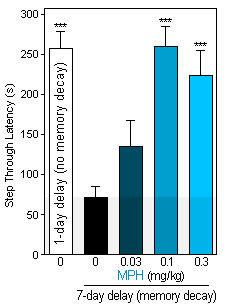via dopaminergic modulation:
methylphenidate’s expanding therapeutic horizons
Newsletter # 118

In vivo studies
Methylphenidate (Ritalin®, MPH) is a first-line treatment for ADHD due to its ability to modulate several components of cognition—including attention, impulsivity, and executive function—through its effects as a dopamine-norepinephrine reuptake inhibitor. Neurofit’s preclinical findings on various ADHD drugs further support this therapeutic profile.
Recent preclinical findings from Neurofit suggest that MPH’s benefits extend beyond ADHD, showing promise in memory consolidation and retrieval. In a rat model of natural forgetting assessed through the passive avoidance paradigm, MPH improved memory performance, highlighting its potential in addressing memory deficits.
Recent preclinical findings from Neurofit suggest that MPH’s benefits extend beyond ADHD, showing promise in memory consolidation and retrieval. In a rat model of natural forgetting assessed through the passive avoidance paradigm, MPH improved memory performance, highlighting its potential in addressing memory deficits.
These findings indicate that MPH or its downstream pathways may be applicable in conditions characterized by cognitive decline, such as mild cognitive impairment (MCI), Alzheimer’s disease (AD), traumatic brain injury (TBI), Parkinson’s disease (PD), schizophrenia, chemobrain, and other age-related cognitive disorders. By enhancing memory processes, MPH could serve as a novel therapeutic strategy for memory-related disorders. Future research should focus on leveraging these findings to develop targeted treatments for cognitive decline and exploring compounds with similar mechanisms to expand therapeutic options.
-
 ***, p ≤ 0.001: significantly different as compared to the black column
***, p ≤ 0.001: significantly different as compared to the black column
-
Effect of MPH on natural forgetting paradigm in rats (memory decay paradigm)
The memory decay paradigm in passive avoidance trains rats to avoid an environment (dark compartment) associated with an aversive stimulus (mild foot shock). Memory retention is evaluated by measuring how long the rats delay stepping through to the environment (step-through latency, or STL). A decrease in STL over time (within 7 days, black column) indicates memory decay, meaning the rats gradually forget the unpleasant association. In contrast, a higher STL after a short delay (1-day, white column) reflects strong memory retention. Treatment with MPH prevents memory decay by increasing STL in a dose-dependent manner (blue columns), showing improved memory consolidation.
Get in touch


 PREVIOUS
PREVIOUS